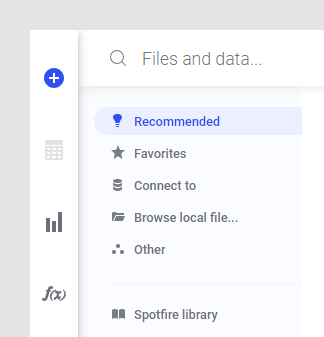Types of data in Spotfire
Data can originate from a multitude of different sources and the trends move towards a general supply of more and more data. It can be a matter of traditional enterprise sources, relational databases, cubes, NoSQL, machine generated data, cloud, streaming data, dark data, unstructured data, big data in Hadoop, Web Services, etc. With Spotfire you have the perfect environment for analyzing any type of data, from any source.
There are a number of different ways available to access your data:
- Direct file access (.xls, .xlsb, .xlsx, .xlsm, .csv, .txt, .stdf, .sbdf, .shp, .geojson) and even more file types using the installed client (.mdb, .mde, .sas7bdat, .sd2, .udl, etc.). You might also have access to additional file sources, if such have been configured by your company. File data is always analyzed in-memory.
-
Data connections via connectors to external systems. The data
connections are well suited to handle big data and each connector is tailored
for its particular source. Custom queries can be created in order to fine-tune
the data returned or the performance of the query. With data connections, you
can usually choose to analyze the data either in-memory or in-database.
Streaming data is a special case of in-database data where the data is updated in real-time, or at any frequency, depending on how you configure your connection to the streaming data. Connections to streaming data work the same way as any other connection.
- Spotfire
Information Services and its configuration tool Information
Designer (available from the installed client only) allows you to set up any
JDBC data source and create information links, which are predefined SQL queries
that can be analyzed in-memory. Information links can include prompts to enable
the end users to select their own data and procedures can be added both as
pre-/post- or main queries. A built SQL query can easily be edited for further
tweaking of the result.
Information links are not available in a Cloud environment.
- TIBCO Data Virtualization (also branded as Spotfire Advanced Data Services) is an interface to other third-party applications, commonly used for access to Web Services.
You can access all types of sources from the Files and data flyout on the authoring bar:

Data from multiple sources can be combined into a single Spotfire analysis and analyzed using a number of different visualization types. If Spotfire detects that new data is similar to previously added data, you will get a recommendation to join your data into a single data table when adding new data to an analysis.
Data from different sources can be shown in a single visualization, or in many. Different data tables can be related to each other so that filtering in one affects the values in another data table, but they can also remain completely separate: there are no limits.
Below is an overview of the different load methods and features available for different access types. See also Load methods for more details.
| Supported? | Connectors | TIBCO Data Virtualization | Information Services |
|---|---|---|---|
| In-database | Yes | Yes | – |
| In-memory | Yes | Yes | Yes |
| On-demand | Yes | Yes | Yes |
| Custom queries | Yes | - | Yes |